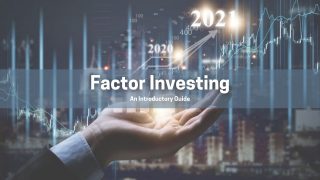[Today’s issue of The Global Guru is a summary of a keynote speech, “Is ‘Smart Beta’ Intelligent Investing?” I gave earlier today at a Citywire “Smart Beta” conference outside of London. You can download a copy of the actual presentation.]
“Smart beta” investment strategies are red hot — not in the least because they are trouncing an already sizzling U.S. stock market in 2013.
“Smart beta” exchange-traded funds (ETFs) have attracted $45 billion in new investment during 2013. By way of comparison, “smart beta” ETF assets grew 43% the first nine months of 2013, versus 16% growth in total ETF assets.
So are “smart beta” strategies merely a passing fad?
Or are they genuinely a “better mousetrap?”
For me the answer is clear…
I’ve been so impressed with the results that I’ve launched a new investment program — “American Alpha” — at my firm Global Guru Capital that invests exclusively in “smart beta” strategies. And I’ve rejigged the Harvard-endowment-tracking “Ivy Plus” Investment Program for 2014 to incorporate “smart beta” strategies as well.
What Are ‘Smart Beta’ Strategies Exactly?
Traditional index funds provide investors exposure to the performance — or beta — of any market. The strategy is straightforward. You buy all of the securities in an index and weight them based on their size or market capitalization.
Index fund evangelists like John Bogle of Vanguard point out that active managers are unable to outperform the market consistently. In addition to outright lack of skill, the combination of high fees and excess trading are a drag on fund performance.
“Smart beta” ETFs offer a clever solution to this conundrum by giving investors the opportunity to outperform the mainstream market indexes, while retaining the benefits of traditional indexation.
Here’s how they do it.
Traditional index funds are based on market-cap indexes. That means that in an S&P 500 Index fund, you end up with a lot more of Apple (AAPL) and Exxon (XM) in your portfolio than you would say, Dollar Tree (DLTR).
“Smart beta” strategies are different.
“Smart” essentially means the index they invest in is not market-cap weighted.
“Beta” confirms that you are still investing in a passive index.
Mainstream index fund providers aren’t too happy with the term “smart beta.” After all, “smart beta” implies traditional index strategies are “dumb.”
None other than William F. Sharpe, Nobel Laureate at Stanford and the originator of the term beta, has said:
“The use of the term beta to represent something other than the decades long accepted meaning is unfortunate, at the very least.”
With that, here is my working definition:
“Smart beta” is simply: “non-traditional” index-based, passive investing.
Three Leading “Smart Beta” Strategies
The number of “smart beta” strategies is growing as quickly as research firms can come up with new alternative indexes to track. That means long-term track records are few and far between.
But here are three of the most basic “smart beta” strategies available in the U.S. market.
“Smart Beta” Strategy #1 — Equally Weighted Index
Instead of having S&P 500 stocks weighted by capitalization, you invest 1/500th of the portfolio in each stock. Since April 2003, the Guggenheim S&P 500 Equal-Weight ETF (RSP) generated average annual returns of 11.3%, versus 8.4% for a traditional S&P 500 ETF.
“Smart Beta” Strategy #2 — Fundamental Screening
Stock selection is based on fundamentals: book value, cash flow, sales and dividends.
In five years ended Sept. 30, PowerShares FTSE RAFI U.S. 1000 (PRF) generated average annual returns of 13.2%, versus 10.02% for a traditional S&P 500 ETF.
As the chart below shows, both strategies outperform the S&P 500, while generating very similar returns, at least since 2006.

Guggenheim S&P 500 Equal-Weight ETF (RSP) vs. PowerShares FTSE RAFI U.S. 1000 (PRF) vs. S&P 500
“Smart Beta” Strategy #3 — Low Volatility Stocks
PowerShares S&P 500 Low Volatility Portfolio (SPLV) consists of the 100 stocks from the S&P 500 Index with the lowest volatility over the past 12 months.
This strategy actually underperforms in bullish markets like the current one, while holding up better in bearish markets.

PowerShares S&P 500 Low Volatility (SPLV) vs. S&P 500
The Secret Behind “Smart Beta” Strategies?
1. The “Small Cap” Effect
Average market capitalization of equal-weight portfolios are less than cap-weighted counterparts.
For example, SPDR S&P 500 (SPY) holds 51.1% in mega-caps, 37.2% in large-caps and 11.7% in mid-caps.
Guggenheim S&P 500 Equal-Weight ETF (RSP) has 12.0% in mega-caps, 43.9% in large-caps and 43.7% mid-caps.
Since small-cap stocks tend to outperform over the long term, this explains a good chunk of “smart beta” strategies’ outperformance.
2. Invest in “Value” over “Growth”
Studies confirm that non-market capitalization index portfolios tend to invest in value stocks. This is most clearly the case in equally weighted “smart beta” portfolios. Smart beta strategies invest in stocks at bargain prices rather than simply track the highest-market-cap stocks.
3. Rebalancing
Equally weighted smart beta indices rebalance quarterly by selling “winners” and buying “losers.” That means returns benefit from the “reversion to the mean.” This is the opposite of market-cap-weighted indices, which add to “winners” with growing market caps.
Is ‘Smart Beta’ Investing’s ‘Free Lunch’?
In “An Investor’s Guide to Smart Beta Strategies,” Jason Hsu, Vitali Kalesnik and Feifei Li (2012) came up with the following revealing chart.
As you can see, every “smart beta” strategy tested resulted in higher returns, beating the market-cap-weighted S&P 500 over 43 years. Both strategies #1 and #2 outperform the market, while strategy #3 has the highest risk-adjusted returns, as measured by the Sharpe ratio.
“Smart beta” strategies tend to outperform mainstream benchmarks by an average of about 2% a year in developed markets. They also offer all of the advantages of passive index investing — low cost and low turnover. In addition, outperformance is higher in less efficient markets and specialist strategies not covered by the study.
Using ‘Smart Beta’ in The Real World
Global Guru Capital’s “American Alpha” investment program equally weights 10 different “smart beta” specialist investment strategies, each tracking a non-traditional index. These “smart beta” strategies include the three strategies discussed above, as well as “buy back” indexes, IPO indexes, “dividend dog” indexes and “spin off” indexes.
This strategy has paid off in a bullish market, outperforming the S&P 500 by over 10% over the past 12 months — although at a cost of higher volatility.

“American Alpha” versus the S&P 500 over the past 12 months
Yet, it is important to remember that “smart beta” is not the “holy grail”…
The small-cap tilt of “smart beta” strategies means that they will perform particularly well in bull markets like the one we’ve had over the past 12 months. “Smart beta” won’t protect you against “Black Swan” events. Most “smart beta” strategies’ small-cap tilt means greater downside volatility. And it’s hard to generate genuine “alpha” — market-beating returns without higher volatility — in both bull and bear markets. Finally, some “smart beta” strategies may underperform some traditional index strategies in certain asset classes.
Yet here’s why “smart beta” strategies work, and why I use them actively in behalf of clients.
“Smart beta” ETFs allow investors to assemble a diversified portfolio of sophisticated, disciplined, quantitative investment strategies at low cost.
They also offer financial advisors the ability to offer to clients a set of sophisticated strategies that outperform traditional index investments and consistently “beat the market.”
And consistently outperforming the markets, year after year, is as close to the “holy grail” as you ever likely will get.
Again, you can download a copy of my original presentation.
In case you missed it, I encourage you to read my e-letter article from last week about the economic rise of Ireland and Spain. I also invite you to comment about my column in the space provided below.





